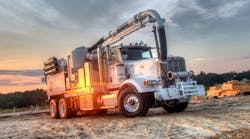Company: Vac-Con Inc. of Green Cove Springs, FL
Operation: A custom builder of vacuum trucks in North America and around the world. Founded in 1986, Vac-Con employs 300-plus people at its Florida headquarters facility where it produces its vac trucks, which are in service in countries around the globe.
Challenge: Build more trucks to keep up with future production goals and demands, and do it in an optimized space.
Vac-Con recently celebrated building its 8,000th truck. It took some time to get there: Each of Vac-Con’s trucks requires some 4,000 parts to be gathered from inventory, and the company could begin work on one to two trucks per day with its old inventory and facilities. There were two warehouses with 71,000 sq. ft. combined floor space — one housing purchased parts and the other manufactured parts—which meant there was some distance to have to cover.
The company’s old parts-picking system had some built-in difficulties. There were 12-ft.-high units with parts workers had to reach for—they’d typically use a ladder — or down low where they’d have to bend and pick them up. “A few items were in an easily pickable spot, but there were a lot that were either on the floor or up too high, and there was a lot you had to do to get them,” explained Ian Beattie, inventory control manager.
Collecting everything with that system to build trucks created constraints. Vac-Con wanted to increase production capacity and streamline its processes as well.
Solution: Implement an improved automatic inventory management system that integrates with current work order systems.
Vac-Con chose to install Kardex Remstar Shuttle XP Vertical Lift Modules, or VLMs, driven by Power Pick Global (PPG) inventory management software. The VLMs are robotic bins that retrieve needed parts from within their enclosed vertical space and deliver them to workers at an ergonomically positioned access point, Beattie explained.
The older warehouses were 25 ft. high, which would allow for 20-ft. VLMs. But Vac-Con was looking to build a new warehouse to replace them, “and the idea was, ‘Well, we haven’t even built the building yet. How high would we have to make it to have the VLMs be 40 ft.?’” Beattie noted. “Because that would mean I need six of them instead of 12.”
Vac-Con built a new 45-ft.-high warehouse to accommodate taller lift modules. It was completed about two and a half years ago and covers just 29,200 sq. ft., meaning it was able to meet the company’s inventory needs with a 59% smaller footprint.
That means dramatically less warehouse space to have to cover. The new inventory system and controlling technology cut down time workers spent walking around to gather parts, which are now also much more easily accessible.
Vac-Con’s computer-based inventory management system receives orders for trucks and creates work orders that are fed into the PPG software system, which drives batch-picking for parts. The PPG system also manages rack storage for larger, heavier parts workers gather with forklifts.
The new inventory management system which Vac-Con now uses has cut down the time that it took to get trucks into production, Beattie told Fleet Owner, and will help the company meet future production goals and handle new designs more flexibly. And on that note, the system also allows flexibility for aftermarket parts orders, which account for about 5% of orders and are pulled manually.
“We’re looking at being able to produce 28 trucks per month right now to 35 trucks a month at the end of the year,” Beattie said. “The goal three years from now is to be doing 50 trucks a month.” And thanks to the improved inventory management system and technology, that higher-capacity future is within reach.





